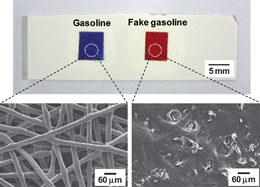Gasoline adulteration poses serious economic and environmental problems in many countries. A “protective layer approach” has been developed for the colorimetric detection of fake and adulterated gasolines. In this approach, a distinct blue-to-red colour change is observed when a conjugated polydiacetylene (PDA)-embedded, electrospun fiber mat is exposed to fake gasoline (a mixture of thinner, toluene, and methanol) and adulterated gasoline (toluene or methanol added to commercial gasoline). The matrix polymer used for electrospinning is found to play a critical role as a protective layer for the embedded colorimetric PDA supramolecules. Thus, chromic transition occurs only when the protective matrix polymer is dissolved by the component of the gasoline. In fact, toluene and methanol were found to facilitate dissolution of the matrix polymer (toluene for polystyrene and methanol for polyacrylic acid) and allows penetration of the adulterated gasoline to the embedded PDA, causing blue-to-red phase transition of PDA. The colour change occurs almost instantaneously (<3 s) and is observable by the naked eye. Thus, complicated instrumental techniques are not required in this approach. Importantly, this smart sensor system is portable, inexpensive, sensitive and it requires minimal amounts (app. 40 µL) of test samples.

You have access to this article
 Please wait while we load your content...
Something went wrong. Try again?
Please wait while we load your content...
Something went wrong. Try again?


 Please wait while we load your content...
Please wait while we load your content...